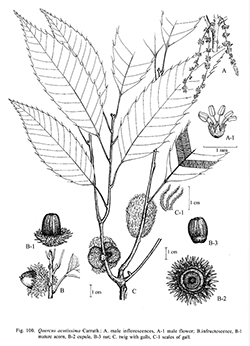e-Flora of Thailand
Volume 9 > Part 3 > Year 2008 > Page 357 > Fagaceae > Quercus
1. Quercus acutissima Carruth.wfo-0000289386
J. Linn. Soc., Bot. 6: 33. 1862; C.C.Huang, Y.T.Chang & B.M.Bartol. in C.Y.Wu & P.H.Raven, Fl. China 4: 1372. 1999. Fig. 100.
Accepted Name : This is currently accepted.
Synonyms & Citations :
Description : Tree, 10–25 m high, 50–150 cm girth. Buds and axillary ovoid, 0.6–1 by 0.3 mm, sparsely silky hairs outside. Twigs tomentose then glabrescent, lenticellate, usually with hairy galls along twig. Bark dark brown, longitudinally furrowed, 1–5 cm thick. Leaves oblong to oblong lanceolate, 7–19 by 3–9 cm; base obliquely obtuse or cordate; apex acuminate or caudate; margins strongly serrate with curved or straight, spine-like tips; chartaceous, pubescent then glabrescent, dull olive-green on the upper surface; yellowish on the lower; midrib and lateral nerves prominent on the lower surface, subdepressed on the upper; lateral nerves 14–17 pairs, straight and protruding to end of serrate margins, scalariform veins conspicuous on the lower surface. Petiole 1–7 cm, pubescent then glabrescent. Male inflorescence a solitary catkin, pendulous, 6–8 cm long, tomentose. Male flowers solitary or in 3–4-flowered cluster. Perianth (5) 6-lobed, lobes lanceolate, ca 0.1 mm long, hairy outside, ciliate; stamens 6–(8–10), 1–1.5 mm long, hairy near base. Female inflorescence spike erect, ca 1 cm long. Female flowers free, 1 3 together; styles 3, connate near base; stigmata capitate. Acorns sessile, ovoid in outline, 2.5–3 by 3–5 cm (including cupule), always 1(2) acorns in each infructescence. Cupule coroniform, enclosing ⅕ to ½ of the nut; wall comprising two kind of scales, the lower triangular, adnate the upper elongate up to 1 by 0.3 cm, horizontal or decurved, inner side fused with nut. Nut ovoid or tubuliform, 2–2.5 by 1.5–1.7 cm, conic or truncate apex; scar up to ⅕ from the base of nut.
Thailand : NORTHERN: Chiang Mai; NORTH-EASTERN: Phetchabun, Loei; EASTERN: Chaiyaphum.
Distribution : India, Nepal (type), Burma, Vietnam, Laos, China, Korea, Japan, U.S.A.
Ecology : Lower montane rain forests, lower montane pine-oak forests, lower montane oak forests, on sandstone bedrock, 650–1,300 m (most commonly 1,000–1,300 m). Flowering: January–March; fruiting: March–November (most commonly September–November).
Vernacular : Ko khi kwang (ก่อขี้กวาง), ko daeng (ก่อแดง), ko up khao (ก่ออุบข้าว)(Northeastern).

